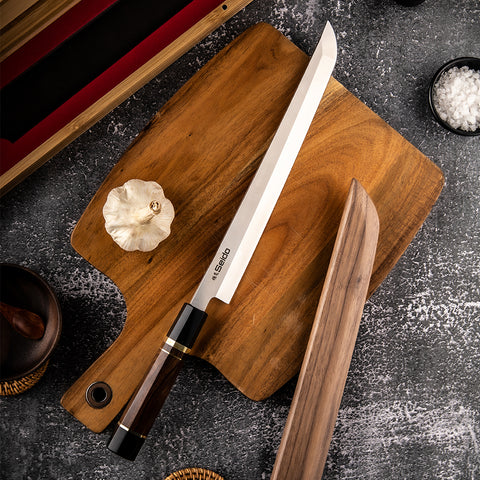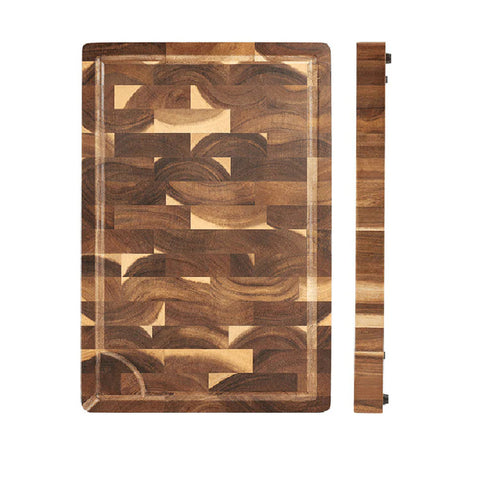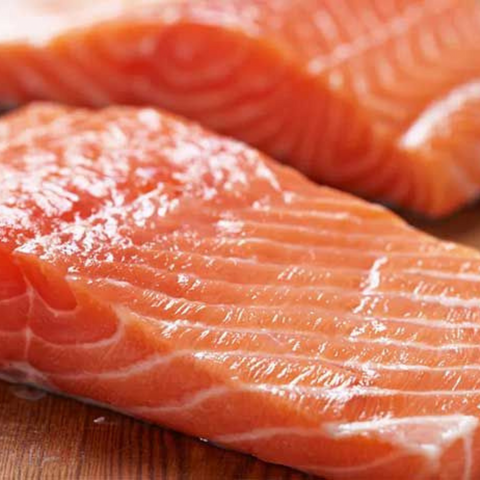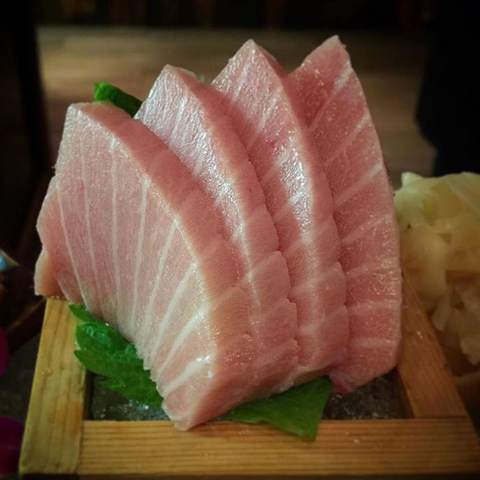Cutting and preparing sashimi and sushi is a skill developed in Japan over centuries. Besides selecting fresh pieces of fish, choosing a good knife is instrumental. When you use our selection of Seido Knives, such as the Sakimaru Takohiki Knife, you can cut and prepare sushi and sashimi like an expert.
EVERYTHING YOU SHOULD KNOW ABOUT SASHIMI
Sashimi is a Japanese dish characterized by thin slices of raw fish. You can make sushi with salmon, tuna, mackerel, yellowtail, and more. The dish is often accompanied by soy sauce, wasabi, and ginger.
SHOULD I CLEAN SASHIMI BEFORE CUTTING IT?
Because sashimi is raw fish, cleaning your fish is a crucial step. You can do this by rinsing your fish in cold water. By cleaning your sashimi, you are removing any superficial parasites or contaminants on the fish.
Master the Art of Preparing Sashimi with Seido Knives!
HOW TO CUT SASHIMI: DIFFERENT TYPES OF SASHIMI-CUTTING TECHNIQUES
HIRA-ZUKURI
The Hira-Zukuri technique involves slicing the fish into rectangular, flat pieces. You will need a sharp sashimi knife, like our Kiritsuke Damascus Chef Knife, to create thin, rectangular slices.

KAKU-ZUKURI
While the Hira-Zukuri technique favors rectangular pieces, the Kaku-Zukuri technique involves cutting sashimi into square or cube pieces.
USU-ZUKURI
The Usu-Zukuri technique emphasizes thin, delicate pieces of fish. Because the slices are paper-thin, this technique is typically challenging to master.
IKI-ZUKURI
The Iki-Zukuri technique involves cutting fish while it is still alive. Iki-Zukuri showcases the quality and freshness of the fish.
ESSENTIAL TOOLS
BEST KNIVES TO CUT SASHIMI WITH
Choosing the right sashimi knife is essential. The Yanagiba knife is one option. This knife offers a long, slender blade that allows you to make precise, thin slices of fish without damaging the fish's fibers.
Another suitable knife is the Takohiki knife, like our Sakimaru Takohiki 10.7-inch knife. This long, lightweight knife will give you precise cuts for any cutting technique you use.

YANAGI: TRADITIONAL JAPANESE SASHIMI KNIVES
As mentioned above, the Yanagi or Yanagiba is the traditional sashimi knife used in Japan. The design has undergone years of refinement, and its sole purpose is for slicing sashimi.
CUTTING BOARD
When you cut sashimi, you will also need a high-quality cutting board. At Seido Knives, we offer the Gourmet Acacia End Grain Cutting Board, which is made from acacia wood and offers end-grain durability.

CUTTING WITH THE GRAIN VS. AGAINST THE GRAIN
Cutting against the grain means slicing across the fish's muscle fibers. This brings out the flavor of the fish and creates a more tender texture. Cutting with the grain, on the other hand, means slicing the fish parallel to its muscle fibers.
HOW TO PREPARE SASHIMI
STEP 1: CHOOSE YOUR FISH
Make sure the fish you choose is fresh and clean. If the fish is whole, the fish's eyes should be clear.

STEP 2: CLEAN YOUR FISH
Remove any skin, bones, and scales from your fish. If your fish has a bloodline, remove that, too. Next, rinse your fish in cold water.

STEP 3: CHOOSE YOUR PREFERRED CUTTING TECHNIQUE
Decide on the cutting technique. You can go with the traditional Hira-Zukuri technique or choose one that suits your style.

STEP 4: PLATE AND ENJOY!
Once you have carefully sliced your fish, add soy sauce and wasabi as sides.

HOW TO CUT SUSHI AND SASHIMI: WHAT KINDS OF KNIVES ARE NEEDED?
Here is a breakdown of some of the knives that can cut sashimi and sushi:
- Yanagiba (Yanagi) knife: traditional sashimi knife
- Takohiki knife
- Sujihiki knife
- Deba knife
- Usuba knife
- Kiritsuke knife
POPULAR TYPES OF FISH TO USE FOR SASHIMI AND SUSHI
SALMON
Salmon has a strong flavor and a smooth texture. As for how to cut salmon sushi, consider the traditional Hira-Zukuri technique.
TUNA
Tuna comes in a few varieties, such as fatty tuna or lean tuna. Tuna has a meaty texture and a mild flavor.
MACKEREL
Mackerel has a firm texture. Many chefs marinate it or cure it to enhance the flavor further.
OCTOPUS
Octopus has a chewy, firm texture. It is often cut into thin slices so that it's easier to chew.
CONCLUSION
Cutting and preparing sashimi and sushi can be a wonderful skill to learn. Once you learn the right cutting techniques and use the proper knives, you can make excellent sashimi presentations.



